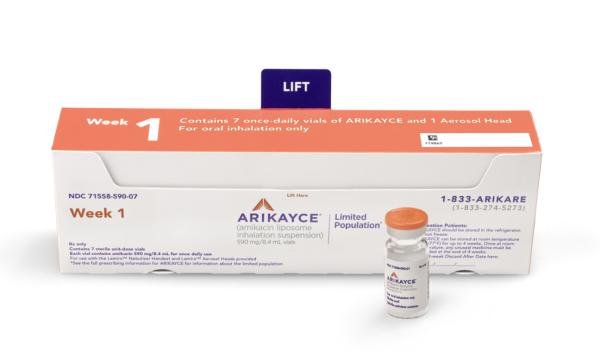Arikayce Disease Interactions
There are 4 disease interactions with Arikayce (amikacin liposome).
Aminoglycosides (applies to Arikayce) neuromuscular disorders
Major Potential Hazard, Moderate plausibility. Applicable conditions: Hypocalcemia, Parkinsonism, Myoneural Disorder, Botulism
Therapy with aminoglycosides should be administered cautiously in patients with neuromuscular disorders (e.g., myasthenia gravis, parkinsonian syndrome, botulism) or hypocalcemia. Aminoglycosides can aggravate muscle weakness because of their potential curare-like effects on the neuromuscular junction, and may cause neuromuscular blockade, respiratory failure, and prolonged respiratory paralysis on these patients. Aminoglycoside- induced neuromuscular blockade is generally self-limiting, it may rarely result in respiratory paralysis. Neomycin is thought to be the most potent neuromuscular blocking agent in the class. However, the risk is greatest with intraperitoneal or intrapleural instillation of large doses or rapid intravenous administration of parenteral aminoglycosides. If signs of respiratory paralysis occur during aminoglycoside therapy, the drug should be discontinued and mechanical respiratory assistance provided if necessary.
Aminoglycosides (applies to Arikayce) ototoxicity
Major Potential Hazard, Moderate plausibility. Applicable conditions: Tinnitus, Hearing Loss
Aminoglycosides can cause eighth cranial nerve damage, resulting in vestibular and/or auditory toxicities. Symptoms include dizziness, nystagmus, vertigo, ataxia, tinnitus, and varying degrees of hearing impairment. Permanent hearing loss may occur, including, rarely, total or partial irreversible bilateral deafness after the drug has been discontinued. Therapy with aminoglycosides, particularly if prolonged (> 10 days), should be administered cautiously in patients with preexisting vestibular and/or auditory impairment, since it may delay the recognition or confound the diagnosis of a drug-induced ototoxic effect. To minimize the risk of toxicity, patients should be adequately hydrated, the usual aminoglycoside dosage should not be exceeded, use with other ototoxic agents should be avoided, and peak and trough serum aminoglycoside concentrations should be periodically determined and dosage adjusted to maintain desired levels. Serial audiograms should be obtained in patients old enough to be tested, since loss of high- frequency perception usually precedes clinical hearing loss. The dosage should be reduced or therapy withdrawn promptly if signs and symptoms of toxicity develop.
Aminoglycosides (applies to Arikayce) renal dysfunction
Major Potential Hazard, Moderate plausibility.
Aminoglycosides are potentially oto- and nephrotoxic. Eighth cranial nerve damage may manifest as vestibular and/or auditory toxicities, including dizziness, nystagmus, vertigo, ataxia, tinnitus, and varying degrees of hearing impairment. Nephrotoxicity is usually evidenced by tubular necrosis; increases in BUN, nonprotein nitrogen, and serum creatinine concentration; decreases in urine specific gravity and creatinine clearance; proteinuria; and cells or casts in the urine. Rarely, renal electrolyte wasting may occur, resulting in hypocalcemia, hypomagnesemia, and hypokalemia that may be associated with paresthesia, tetany, confusion, and positive Chvostek and Trousseau signs. Although aminoglycoside- induced nephrotoxicity is generally reversible following discontinuation of the drug, death from uremia has occurred rarely. Therapy with aminoglycosides should be administered cautiously at reduced dosages in patients with renal impairment, since they may be at increased risk for oto- and nephrotoxicity due to drug accumulation. To minimize the risk of toxicity, patients should be adequately hydrated, the usual aminoglycoside dosage should not be exceeded, use with other neuro- and nephrotoxic agents should be avoided, and peak and trough serum aminoglycoside concentrations should be periodically determined and dosage adjusted to maintain desired levels. Renal and eighth cranial nerve function should be closely monitored, and the dosage reduced or therapy withdrawn if toxicity develops.
Amikacin liposome (applies to Arikayce) pulmonary disease
Moderate Potential Hazard, Moderate plausibility. Applicable conditions: Pulmonary Impairment
Higher frequency of exacerbations of underlying pulmonary disease has been reported with amikacin liposome treatment. Monitor closely patients with pulmonary impairment and treat as medically appropriate if this occurs during treatment with amikacin liposome. Pre- treatment with short-acting selective beta- 2 agonists should be considered for patients with known hyperreactive airway disease, chronic obstructive pulmonary disease, asthma, or bronchospasm.
Switch to professional interaction data
Arikayce drug interactions
There are 203 drug interactions with Arikayce (amikacin liposome).
More about Arikayce (amikacin liposome)
- Arikayce consumer information
- Check interactions
- Compare alternatives
- Pricing & coupons
- Drug images
- Side effects
- Dosage information
- During pregnancy
- FDA approval history
- Drug class: aminoglycosides
- En español
Related treatment guides
Drug Interaction Classification
| Highly clinically significant. Avoid combinations; the risk of the interaction outweighs the benefit. | |
| Moderately clinically significant. Usually avoid combinations; use it only under special circumstances. | |
| Minimally clinically significant. Minimize risk; assess risk and consider an alternative drug, take steps to circumvent the interaction risk and/or institute a monitoring plan. | |
| No interaction information available. |
See also:
Further information
Always consult your healthcare provider to ensure the information displayed on this page applies to your personal circumstances.


